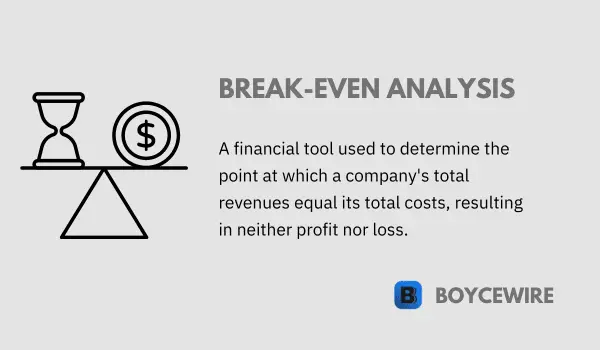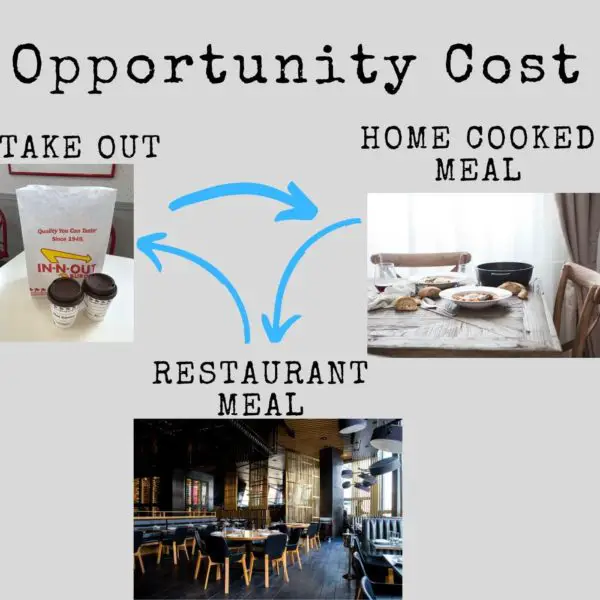Break-Even Analysis: Definition, Formula & Examples

What is Break-Even Analysis?
Understanding the financial dynamics of a business is a critical task for managers, investors, and entrepreneurs. One of the most valuable tools in this analysis is break-even analysis, a simple yet powerful concept that reveals the sales volume at which a company neither makes a profit nor incurs a loss—its break-even point.
At its core, break-even analysis provides critical insight into the relationship between costs, volume, and profits. It allows businesses to determine the minimum output they need to achieve to cover all their costs and begin making a profit. Moreover, break-even analysis assists in making informed decisions regarding pricing strategies, production levels, and potential expansion, making it an indispensable tool for effective business planning and forecasting.
Key Points
- Break-even analysis is a financial tool used to determine the sales volume needed to cover all costs and achieve a break-even point.
- It helps businesses assess the minimum level of sales required to avoid losses and start generating profits.
- The key components of break-even analysis are fixed costs, variable costs, unit contribution margin, and break-even point.
Understanding Break-Even Analysis
The break-even point is a critical juncture in a business’s financial trajectory, representing the moment at which the company’s total revenue matches its total costs. At this point, the business is not making a profit, but it is not incurring a loss either—it is breaking even.
The concept is significant for several reasons. For one, understanding where the break-even point lies provides valuable perspective on a business’s risk and profitability profiles. Businesses with higher break-even points bear more risk because they require more sales to cover their costs. Conversely, businesses with lower break-even points might be more resilient to changes in the market, as they need fewer sales to cover their costs.
Additionally, knowing the break-even point helps managers and decision-makers set realistic sales targets. For a business to be profitable, it must surpass its break-even point—its sales must exceed the volume at which revenues equal costs. Consequently, understanding where this point lies can inform the setting of strategic objectives and the planning of operational tactics.
Moreover, the break-even point is a dynamic figure. Changes in fixed and variable costs, as well as modifications to the product price, can shift this threshold. This interplay underlines the importance of continuously revisiting the break-even point as part of a company’s ongoing financial analysis.
In the next section, we will look at the different components that play into the calculation of the break-even point as part of a break-even analysis.
Components of Break-Even Analysis
Break-even analysis involves the interplay of various components, primarily fixed costs, variable costs, and the contribution margin. Understanding these elements is essential to conducting a break-even analysis.
- Fixed Costs Fixed costs are those expenses that do not change with the level of output or sales in the short term. These could include costs such as rent for business premises, salaries of permanent staff, insurance premiums, and depreciation of assets. Fixed costs are incurred regardless of whether the business is producing or selling anything, and they must be paid even if the business’s revenue falls below expectations.
- Variable Costs Variable costs, on the other hand, change in direct proportion to the level of production or sales. These can include costs like raw materials, direct labor costs (if workers are paid per item produced), utilities tied to production processes, and sales commissions. The more a company produces or sells, the higher its variable costs will be.
- Contribution Margin The contribution margin represents the portion of each sale that contributes to covering fixed costs and generating profit. It’s calculated by subtracting the variable cost per unit from the selling price per unit. The resulting figure is the amount from each unit sold that goes toward paying off fixed costs. Once all fixed costs have been covered, any further sales contribute directly to profit.
The interplay between these components is what determines the break-even point—the level of sales at which total revenues (price per unit times quantity sold) equals total costs (fixed costs plus variable costs). Understanding these components and their relationships is vital to the effective use of break-even analysis in business planning and decision-making.
How to Perform a Break-Even Analysis
Performing a Break-Even Analysis
Performing a break-even analysis involves a series of steps that use the components discussed earlier: fixed costs, variable costs, and the selling price of the product or service. Here’s how you can calculate the break-even point:
- Calculate the Contribution Margin per Unit First, determine the contribution margin per unit, which is the selling price per unit minus the variable cost per unit. This calculation shows how much of each sale will contribute to covering your fixed costs.
- Calculate the Contribution Margin Ratio The next step is to calculate the contribution margin ratio. This ratio represents the percentage of each sale that contributes to covering fixed costs. To calculate it, divide the contribution margin per unit by the selling price per unit.
- Calculate the Break-Even Point Finally, you can calculate the break-even point in units by dividing the total fixed costs by the contribution margin per unit. This gives you the number of units you must sell to cover your fixed costs.
Alternatively, you can calculate the break-even point in sales dollars by dividing the total fixed costs by the contribution margin ratio. This will give you the total revenue you need to generate to cover your fixed costs.
The break-even point, whether expressed in units or in sales dollars, represents the minimum output or sales level at which the business will not incur a loss. Beyond this point, every additional unit sold or dollar of revenue generated will contribute to profit.
In the next section, we will explore various applications of break-even analysis in business operations and financial decision-making.
Applications of Break-Even Analysis
Break-even analysis is a versatile tool that can be applied in numerous areas of business management and decision-making. Its most important applications are in business planning, financial modeling, and pricing strategy.
1. Business Planning
In the early stages of a business or when launching a new product, break-even analysis can help entrepreneurs set realistic sales targets. By knowing how many units they need to sell or how much revenue they need to generate to cover their costs, business owners can gauge the feasibility of their plans and adjust their strategies accordingly.
2. Financial Modeling and Forecasting
In financial modeling, break-even analysis can be used to forecast future performance under different scenarios. By adjusting variables such as price, cost, and output, managers can simulate various situations and anticipate their financial implications. This could be particularly useful when considering potential expansions, changes in cost structure, or shifts in market conditions.
3. Pricing Strategy
Break-even analysis can also be instrumental in determining pricing strategies. By understanding how the selling price affects the break-even point, businesses can find the optimal price that maximizes profit while keeping the break-even volume achievable. Similarly, it can also help assess the impact of potential discounts or price increases.
4. Risk Assessment
Understanding where the break-even point lies can help assess business risks. Companies with higher break-even points are more exposed to fluctuations in demand and cost changes. Break-even analysis can help evaluate this vulnerability and contribute to risk management strategies.
Limitations and Criticisms of Break-Even Analysis
While break-even analysis is a valuable tool, it is not without limitations. Understanding these constraints is important to avoid misinterpretations and misguided decisions.
1. Assumption of Constant Costs
Break-even analysis assumes that variable costs will change proportionately with output and that fixed costs will remain constant, regardless of the level of production. In reality, costs can be semi-variable (part fixed, part variable) and can change at different rates. For instance, buying raw materials in bulk can reduce the variable cost per unit due to quantity discounts.
2. Assumption of Stable Selling Price
The analysis assumes that the selling price per unit remains constant, which may not always be the case. In practice, selling prices can change due to various factors such as market demand, competition, and changes in input costs.
3. Single Product Focus
Traditional break-even analysis is simpler when a company sells a single product. It becomes more complex when a company has multiple products with different prices, costs, and demand levels. More sophisticated techniques, such as weighted average contribution margin, may need to be used in these cases.
4. Overemphasis on Break-Even Point
The break-even point should not be the sole focus of business decision-making. Profitability and cash flow considerations are also vital. A business might be able to break even at a particular sales volume but may not generate sufficient cash flows or profits to sustain operations in the long term.
Examples of Break-Even Analysis
Understanding how break-even analysis works in real-life scenarios can help contextualize its principles and applications. Let’s look at a few examples.
Example 1: Manufacturing Business
Suppose a small manufacturing business produces a single type of product. It incurs fixed costs of $10,000 per month (rent, salaries, etc.) and variable costs of $5 per unit produced (materials, utilities, etc.). Each unit of the product is sold for $15.
The contribution margin per unit would be $15 (selling price) – $5 (variable cost) = $10. The break-even point would then be $10,000 (fixed costs) / $10 (contribution margin per unit) = 1,000 units. The business needs to sell 1,000 units per month to break even.
Example 2: Service Business
Now, consider a service business like a consultancy firm. Its fixed costs are $5,000 per month (office rent, utilities, etc.), and it charges clients $200 per hour of consulting. There aren’t any significant variable costs associated with each consulting hour.
The break-even point in this case would be $5,000 (fixed costs) / $200 (revenue per hour) = 25 hours. The firm needs to bill 25 hours of consulting per month to cover its costs.
Example 3: Retail Business
A clothing retailer incurs fixed costs of $20,000 per month (store rent, salaries, etc.) and purchases clothes at a wholesale cost of $20 per item, which it sells at a retail price of $50.
The contribution margin per item would be $50 (selling price) – $20 (variable cost) = $30. Thus, the break-even point is $20,000 (fixed costs) / $30 (contribution margin per item) = approximately 667 items. The retailer needs to sell approximately 667 clothing items per month to break even.
FAQs
Break-even analysis is a financial technique used to determine the level of sales needed for a business to cover all its costs and achieve a break-even point.
Break-even analysis helps businesses assess the minimum sales volume required to avoid losses and provides insights into the profitability of different products, pricing strategies, and cost structures.
The key components of break-even analysis are fixed costs, variable costs, unit contribution margin, and break-even point, which represents the sales volume needed to cover all costs.
Break-even point is calculated by dividing fixed costs by the unit contribution margin, which is the difference between the selling price per unit and variable cost per unit.
About Paul
Paul Boyce is an economics editor with over 10 years experience in the industry. Currently working as a consultant within the financial services sector, Paul is the CEO and chief editor of BoyceWire. He has written publications for FEE, the Mises Institute, and many others.

Further Reading
 Stagflation - Stagflation is an economic condition characterized by a combination of stagnant economic growth, high unemployment rates, and high inflation.
Stagflation - Stagflation is an economic condition characterized by a combination of stagnant economic growth, high unemployment rates, and high inflation.  Examples of Socialism in America - In America, examples of socialism include the New Deal programs, progressive taxation and social welfare policies, public education and healthcare…
Examples of Socialism in America - In America, examples of socialism include the New Deal programs, progressive taxation and social welfare policies, public education and healthcare…  Opportunity Cost: What it is, Types & Examples - Opportunity cost is the price we pay to take one action over another.
Opportunity Cost: What it is, Types & Examples - Opportunity cost is the price we pay to take one action over another. 